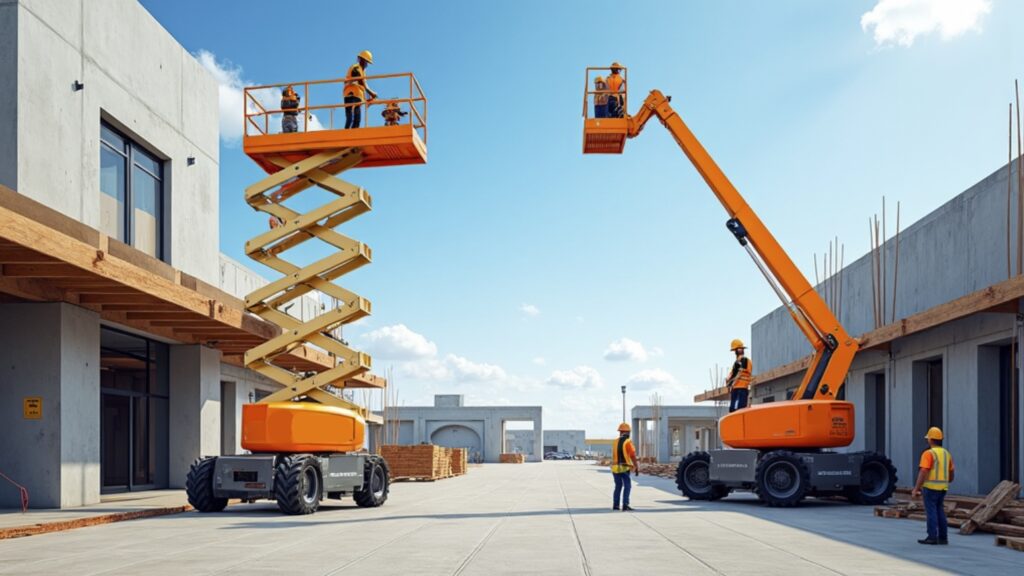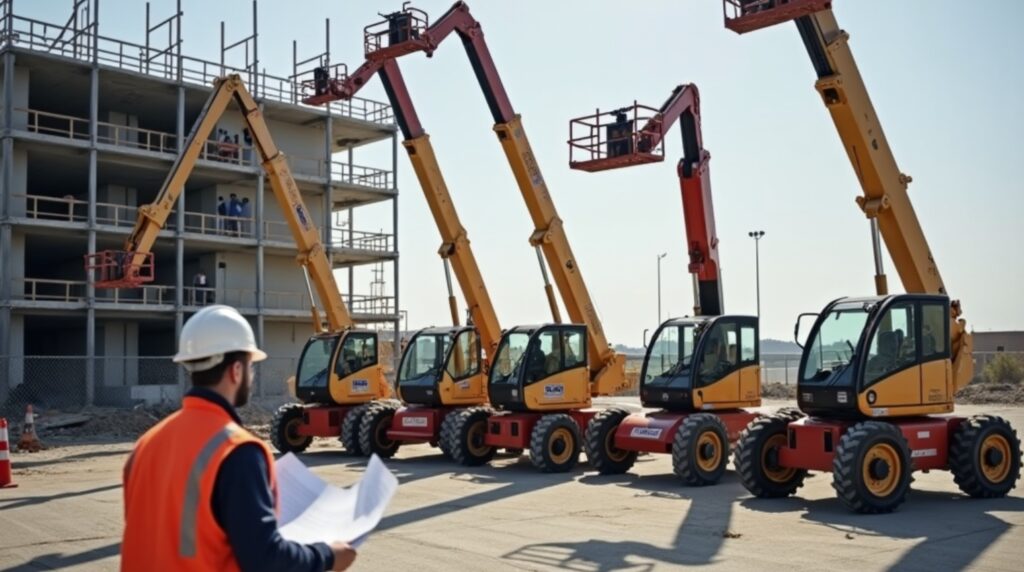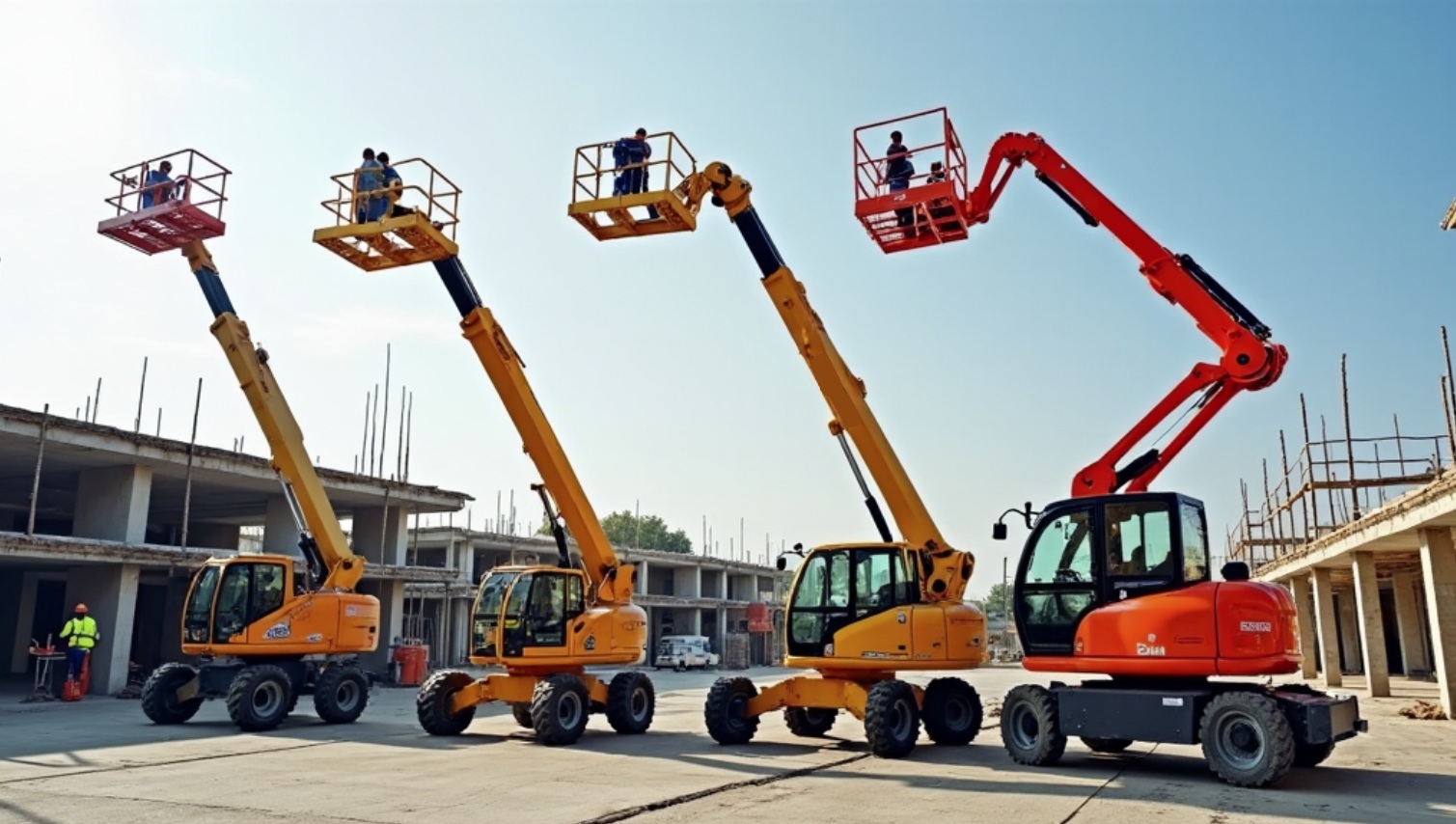In the construction industry, types of boom lifts are crucial for safely reaching high places and working around obstacles. These powerful machines act like an extending arm, allowing workers to perform tasks at various heights, whether they’re installing lights, painting, or conducting inspections. This guide will help you understand the different boomlifts available and their specific uses. By knowing how to choose the right equipment, you can enhance your job site’s productivity and safety, ensuring that every task is completed efficiently and securely. Let’s dive into the world of boomlifts!
1. Understanding Boomlifts
Overview of Boomlifts and Their Purpose in Construction
Boomlifts are amazing machines used to help workers reach high places safely in construction projects. Think of them as giant, mobile platforms that let teams work on rooftops, tall buildings, and other high spots without climbing ladders. They come in various types, making them suitable for different jobs. For example, a telescopic boom lift can extend straight up, while an articulating boom lift can reach over obstacles. This flexibility is important in construction because it allows workers to access challenging spots quickly and efficiently.
Mechanics of Boomlifts
The way boomlifts operate is fascinating. They use a hydraulic system to lift and lower the platform. These systems work by controlling fluid pressure, enabling the boom to extend and retract smoothly. Operators can manage these movements with boom lift controls that are designed for ease of use. Safety is a top priority, so modern boomlifts include features like safety harnesses and emergency stop buttons, ensuring that everyone stays protected while working at great heights.
Importance of Certifications and Training for Operators
To operate a boomlift, it’s crucial for the operator to be trained and certified. This training helps ensure that they understand the safety features and how to handle the equipment properly. Without proper training, the risk of accidents increases, which can lead to injuries on the job site. Certification programs teach operators about boom lift safety guidelines, how to assess ground conditions, and even how to perform regular maintenance checks. This knowledge contributes to a safer work environment and boosts workforce productivity on construction sites.
In summary, boomlifts are essential tools in the world of construction, providing both efficiency and safety. With the right understanding of their mechanics and the importance of proper training, workers can use these powerful machines to tackle construction challenges head-on.
2. Types of Boomlifts

2.1 Articulating Boom Lifts
Articulating boom lifts are like superheroes for construction sites. They can stretch and bend their arms, allowing workers to reach high places and get around obstacles. This ability to navigate tight spots makes them perfect for construction projects where space is limited.
These lifts are versatile, meaning you can use them for various jobs. Whether you need to paint a high wall or fix electrical issues, an articulating boom lift can help. Most come with a good platform size for team members and tools, and they can handle substantial load capacity. This means you can safely lift yourself and your equipment without worrying about stability.
2.2 Telescopic Boom Lifts
Telescopic boom lifts are designed to reach new heights—literally! They extend straight out and can lift workers as high as 60 feet or more. This makes them ideal for urban construction, especially when working on tall buildings.
These lifts are stable, with strong safety features that keep operators safe while working at great heights. Just like a skyscraper reaching for the sky, they provide excellent height access for any construction job. Workers can confidently perform their tasks knowing their stability is secure, allowing for efficient and safe operations.
2.3 Cherry Pickers
When it comes to smaller jobs like electrical work or maintenance, cherry pickers are the go-to option. These lifts have a fun historical background—originally designed for picking cherries from high trees, they evolved into handy tools for various tasks.
Today, cherry pickers are compact and perfect for tight job sites. They can squeeze into spaces where larger lifts can’t fit, making them a popular choice for maintenance work. Their design is user-friendly, allowing quick setup and take down, which helps keep projects running smoothly.
2.4 Electric Boom Lifts
Electric boom lifts are an eco-friendly choice for construction projects. They don’t emit harmful fumes and are quieter than their diesel counterparts. This makes them ideal for indoor projects, like working in warehouses or shopping malls, where noise can be a problem.
These lifts are efficient and require specific maintenance to keep their electric systems running smoothly. Their environmental impact is minimal, making them a smart choice for companies looking to be more sustainable in their operations.
2.5 Diesel Boom Lifts
For tough outdoor conditions, diesel boom lifts shine. They are built to handle rugged construction environments and can reach impressive heights. These lifts offer great load distribution, allowing them to lift heavy materials safely and efficiently.
While diesel lifts are powerful, it’s essential to follow operational guidelines for fuel efficiency and manage emissions properly. Keeping these points in mind ensures that you get the best performance while being mindful of the environment.
In summary, understanding the types of boomlifts in construction can help you choose the right equipment for your job site. Each type has its unique features and benefits that cater to different needs, whether you’re looking for versatility, height, compactness, eco-friendliness, or rugged strength. Selecting the right boom lift can make all the difference in productivity and safety on your construction project.
3. Scissor Lifts vs. Boomlifts
When it comes to lifting equipment in construction, two popular options are scissor lifts and boomlifts. They each have unique features, making them suited for different tasks. Let’s dive into how they compare in terms of reach, stability, and versatility.
Reach and Versatility
Scissor lifts are designed to move straight up and down. They are great for jobs that require working at a specific height but don’t need to extend outward. For example, if you’re painting a tall wall or changing light fixtures in a warehouse, a scissor lift can get you there without any fuss.
On the other hand, boomlifts come in two types: telescopic boom lifts and articulating boom lifts. Telescopic boom lifts stretch straight out, while articulating boom lifts can reach over obstacles. This makes boomlifts perfect for working in tight spaces or over large equipment on a job site. Imagine needing to repair a roof or do tree trimming in a crowded area; a boomlift gives you the outreach to get the job done safely.
Stability and Safety
Both types of lifts have their own safety features. Scissor lifts generally have a wider base, offering more stability when working at height. However, boomlifts, especially articulating ones, come with a counterweight and can be adjusted to maintain balance, even on uneven ground.
Safety protocols for each lift also differ. When using a scissor lift, operators must ensure the ground is stable and follow safety guidelines for the lift’s height and load capacity. Regular inspections are crucial to ensure that the hydraulic system and other safety features are in good working order. For boomlifts, it’s essential to undergo operator training and follow the operational guidelines since they can operate at greater heights and in more complex environments.
In summary, choosing between a scissor lift and a boomlift depends on your specific needs. If you require a stable platform to work straight up, the scissor lift is your best bet. But if you need to access hard-to-reach areas, a boomlift is the way to go! Always prioritize worker safety and adhere to the necessary protocols to ensure a successful lift operation.
4. Choosing the Right Boomlift for Your Project

When you start a construction project, you need the right tools to get the job done safely and efficiently. One of the most important tools is a boomlift. Choosing the right one can make a big difference in how well your project goes.
Assessing Your Project Needs
First, think about what you really need. How high do you need to reach? This is called working height. If you’re working on a tall building, you might need a telescopic boom lift that can extend high up. For jobs that need to reach over obstacles, an articulating boom lift is better because it can bend and reach into tight spots.
Next, consider the ground conditions. Is the ground soft and muddy, or hard and stable? If the ground isn’t reliable, you need a heavy-duty lift that can handle that. Also, think about how much weight the lift needs to carry. This is called load capacity. If you have heavy equipment or a lot of workers, make sure the lift can support that weight.
Factors Influencing Selection
Don’t forget about the way you’ll move the lift around the job site. Site logistics are important! If your worksite is small, you might want a compact boom lift that can easily fit in tight spaces. For larger areas, a bigger lift with more outreach could be the right choice.
Finally, consider your budget. Sometimes it’s better to rent a boomlift instead of buying one. This way, you can choose the best lift for each project without breaking the bank. Boom lift rental options give you the flexibility to pick the right equipment every time, whether you need an electric boom lift for indoors or a diesel boom lift for outdoor jobs.
In conclusion, picking the right boomlift isn’t just about height. It’s about understanding your project needs, considering load capacity, ground conditions, site logistics, and budget. By taking all these factors into account, you can ensure that your project runs smoothly and safely.
5. Maintenance Tips for Boomlifts
Regular Maintenance Practices
Keeping your boomlift in good shape is super important for safety and efficiency on the construction site. Regular maintenance helps ensure that the machine works well and keeps workers safe. This means checking things like the hydraulic system, which lifts the platform, and making sure all safety features are functioning properly. Think of it like taking care of a pet; if you feed it, clean it, and check for any problems, it will be happy and healthy!
Importance of Inspections and Operator’s Manuals
Before using a boomlift, always consult the operator’s manual. This manual has specific instructions that can help you understand how to operate the lift safely. It’s like following a recipe when making a cake—you want to get it right! Also, inspections should be done regularly. Look for signs of wear and tear, and make sure everything is working as it should. Regular inspections can catch small issues before they turn into big problems, keeping everyone safe on the job site.
Maintenance Checklist
To help you remember what to check, here’s a simple maintenance checklist:
- Hydraulic System Checks: Look for leaks and ensure fluid levels are correct.
- Safety Harness Inspections: Check that harnesses are not damaged and are in good condition.
- Platform Condition: Make sure the platform is clean and free from debris.
- Controls Functionality: Test the boom lift controls to ensure they respond properly.
- Tires and Stability: Inspect tires for wear and ensure the lift is stable on the ground.
By sticking to these maintenance tips, you can keep your boomlifts operating smoothly and safely, which is a win for everyone involved!
6. Safety Considerations for Using Boomlifts
6.1 Operator Training
When it comes to boomlifts, operator training is crucial. Imagine if someone tried to ride a bike without knowing how to balance! That’s how important training is for operating boomlifts safely. Without proper training, operators can face risks like accidents or injuries. They might not know how to handle the hydraulic system or understand the machine’s safety features.
Training programs teach operators the right way to use the equipment, how to check the platform size, and ensure the load capacity isn’t exceeded. If an accident happens, it’s vital to know the emergency protocols. For instance, operators should be aware of how to safely lower the lift and get everyone down quickly.
6.2 Boom Lift Safety Guidelines
To keep everyone safe on the job site, following specific boom lift safety guidelines is essential. First, always adhere to construction regulations. This helps prevent accidents and keeps the worksite running smoothly. For example, wearing a safety harness is a must when using an aerial lift. It helps secure you while you’re reaching new heights!
Another tip is to always perform a quick inspection before using the boom lift. Check the stability of the ground and ensure the outreach is appropriate for the tasks at hand. Using stabilizers can help improve balance while lifting. Remember, safety first! Keeping these guidelines in check will enhance workplace safety and ensure everyone gets home safely after a long day of work.
7. Innovations in Boomlift Technology
Recent Advancements in Boomlift Design and Functionality
Boomlifts have come a long way! Recent innovations in boomlift technology have made them safer and easier to use. For example, many new models now include electric boom lifts that reduce fuel consumption and offer quieter operation. These lifts are great for indoor projects and help keep work areas calm and clean. Articulating boom lifts are also getting better, allowing them to reach tricky spots with ease. Imagine needing to fix a roof; these lifts can twist and turn to get you right where you need to be!
Improving Safety and Efficiency on Job Sites
Safety is always the top priority on any job site. New safety features, like automatic shut-off systems and improved operator training, help keep workers safe while using aerial lifts. For instance, if the lift starts to tip, an alarm sounds to warn the operator. These features not only enhance worker safety but also boost overall worksite efficiency.
Trends in Remote Operation and Enhanced Fuel Efficiency
One exciting trend is remote operation. Operators can control mobile elevating work platforms from a distance, making it safer to work in high places. This means fewer risks, especially when working with heavy loads. Plus, with advancements in fuel efficiency, many new lifts consume less fuel, making them better for the environment and reducing costs for construction companies. With all these changes, boomlifts are becoming smarter and more efficient, ensuring that construction projects run smoothly and safely.
Completing Your Boomlift Experience
Now that you’re equipped with insights into the types of boomlifts in construction, it’s time to put that knowledge to work! Remember, choosing the right equipment can make all the difference in your project’s success. Whether you’re a professional contractor or a DIY enthusiast, Rentalex offers a wide range of top-brand tools and equipment to meet your needs. Reach out to us at (813) 971-9990 or visit our Tampa location today to explore your options. Let’s elevate your construction projects together!






